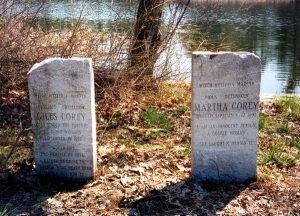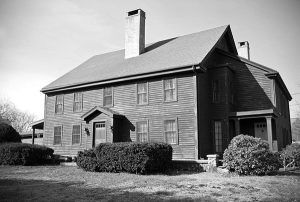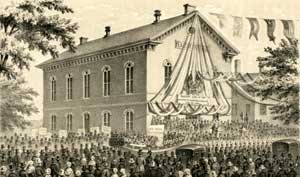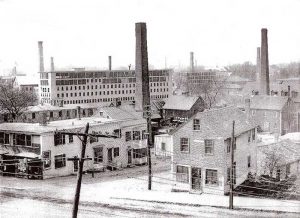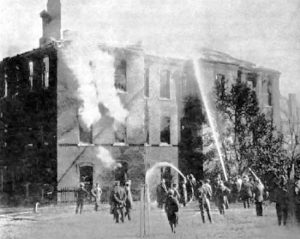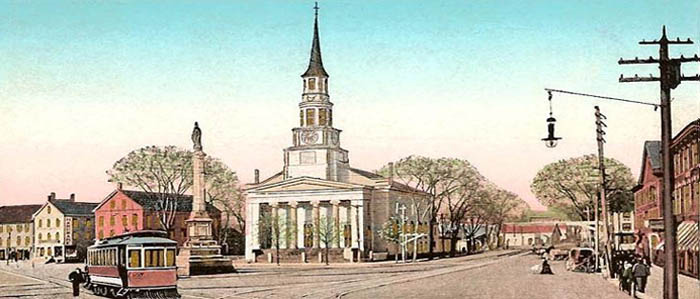
Peabody, Massachusetts Square
Peabody, Massachusetts, a suburb of Salem, was first known by several names when it was settled in about 1626, including Northfields, Salem Farms, and Brooksby.
It was settled at the same time as Salem and, for more than a century, would be just another part of the city. Peabody started off as a farming community, but when the first settlers arrived and traded with the local Native Americans, they found that the Indians had been producing leather in the area for years. Many of the new settlers also began utilizing the area’s abundant supply of fresh running water for the tanning process.
In 1752, the area was set off from Salem and incorporated as part of Danvers, which was once called Salem Village. At that time, it was usually referred to as “the South Parish,” associated with the church located in the center of town (now Peabody Square).
By 1770, the leather-making industry was growing in the fledgling city.
During the witch hysteria of 1692, three of the town’s first residents — Giles Corey and John Proctor — were found guilty and condemned to die for witchcraft. John Proctor’s wife, Elizabeth, was also found guilty and sentenced to hang; but received a reprieve because she was pregnant.
At that time, Peabody was still part of Salem Town. Giles Corey owned a large farm in the area of what is now Pine Street across from the old Post Office at the railroad crossing. Giles was pressed to death with stones after refusing to make a plea in his accusation of witchcraft. His wife Martha was also executed by hanging for being a witch. Their graves sit near their original homestead by Crystal Lake in West Peabody.
John Proctor, an early opponent of the witch hunt, was also hanged during the witch hysteria of 1692. He, too, owned a large farm in what is now Peabody, and the house that he once lived in continues to stand. John and his wife, Elizabeth Bassett Proctor, would both be found guilty and condemned to hang. John’s sentence was carried out n August 19, 1692, but Elizabeth was given a reprieve because she was pregnant. She would later be released and remarried. Their children, Sarah and William Proctor, and John’s oldest son, Benjamin Proctor, from his first marriage, would also be accused. Also living in the house was a servant named Mary Warren, who would become one of the so-called “afflicted girls.” Privately owned today, the house is located at 348 Lowell Street. A stream runs behind the house that is known today as Proctor Brook.
In September 1854, the Peabody Institute Library was dedicated. The public library was founded by George Peabody, a highly regarded philanthropist who lived in Peabody. Later Peabody would also donate the money to open another Peabody Institute Library in Danvers and many other libraries and schools throughout the country. Listed on the National Register of Historic Places, the library building at 82 Main Street is the oldest public library in the United States to operate out of the same location.
By this time, Peabody’s area rivers and streams had attracted several mills which operated by water power and fueled the leather industry. The town was soon nicknamed “Tanner City” due to its success in leather manufacturing.
In 1855, the community broke away from Danvers to become the town of South Danvers. At that time, there were 27 tanneries and 24 currying establishments in the city.
When the Civil War began, it caused a depression in the tanning industry. However, when the War of Rebellion was over, the industry picked up again.
In 1868, the town’s name was changed from South Danvers to Peabody after George Peabody, the philanthropist who had built the library.
By 1870, leather production had increased again, and the town had become one of the leading manufacturers of leather in the area.
In 1894, Arthur C. Lawrence established his A. C. Lawrence Leather Company, employed thousands of workers, and secured the city’s place in history as the largest manufacturer of calf and sheepskins in the world. By the turn of the century, these many manufacturers were bringing numerous workers into the city of Peabody, many of whom were immigrants from 21 different countries.
By 1914, Peabody and Philadelphia, Pennsylvania, were the largest leather-producing cities on the east coast. However, some four years later, Peabody was recognized as the world’s largest producer of leather and was widely referred to as “The Leather City.” At this time, there were 91 establishments dedicated to the production and processing of leather.
Unfortunately, the next year, Peabody suffered a terrible blow when a devastating fire occurred at St. Johns Catholic School on Chestnut Street. On the morning of October 28, 1915, a fire started in the school’s basement, and the teachers quickly began to usher the 600 children out of the building. However, there were no fire escapes outside the building, and as the fire rapidly swept through the three-story brick and wooden school, there was not enough time to get everyone out. With the blaze fully engulfing the building in less than five minutes, twenty-one girls between the ages of 7 and 17 were burned or crushed to death while attempting to escape. The cause of the fire is believed to have been arson. As a result of this fire, Peabody became the first city to pass a law that said all entrances or exits in public buildings be push-open rather than by a handle or a knob.
The tanneries that lined Peabody’s Walnut Street remained very productive and active into the second half of the 20th century. However, residents and employees became increasingly concerned with harmful chemicals that affected both the water supply and the health of the leather workers. To correct these concerns, various upgrades would be required of the manufacturing facilities to meet new costly environmental standards. In the next years, the factories and mills began to shut down, and by the 1970s, most of the remaining companies moved overseas.
Though only one leather tannery remains in Peabody today, the city remains known locally as the Leather City or Tanner City. The mascot of Peabody Veterans Memorial High School is named the Tanners.
The loss of the tanneries was a huge blow to Peabody’s economy, but the city has made up for the erosion of its industrial base, at least in part, through other forms of economic development.
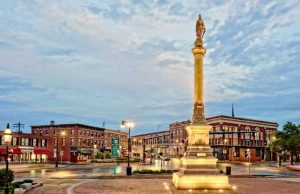
Peabody, Massachusetts, today courtesy City of Peabody.
Today, Peabody is known for its diversity, natural beauty, and historical and cultural amenities. It is called home to about 53,000 people. It is located just two miles northwest of the city center of Salem and about five miles south of Danvers.
© Kathy Alexander/Legends of America, updated July 2023..
Also See:
The Salem Witchcraft Hysteria (main article)
Timeline of the Salem Witchcraft Events
Sources:

